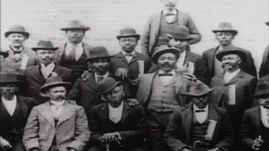Teachers' Domain - Digital Media for the Classroom and Professional Development
User: Preview

Source: The Rise and Fall of Jim Crow: "Promises Betrayed"
After the Civil War, Radical Republicans in Congress believed former slaves would need support from the federal government to protect their new rights. Many white Southerners disagreed, often taking violent action to intimidate African Americans. This video shows some of the ways the South responded to Reconstruction.
Reconstruction refers to the period in United States history immediately following the Civil War in which the federal government set the conditions that would allow the rebellious Southern states back into the Union. In 1862, Abraham Lincoln appointed provisional military governors to re-establish governments in Southern states recaptured by the Union Army. The main condition for re-admittance was that at least 10 percent of the voting population in 1860 take an oath of allegiance to the Union. Aware that the Presidential plan omitted any provision for social or economic reconstruction -- or black civil rights -- the anti-slavery Congressmen in the Republican Party, known as the Radicals, criticized Lincoln's leniency. The Radicals wanted to ensure that newly freed blacks were protected and given their rights as Americans. After Lincoln's assassination in April of 1865, President Andrew Johnson alienated Congress with his Reconstruction policy. He supported white supremacy in the South and favored pro-Union Southern political leaders who had aided the Confederacy once war had been declared.
Southerners, with Johnson's support, attempted to restore slavery in substance if not in name. In 1866, Congress and President Johnson battled for control of Reconstruction. The Congress won. Northern voters gave a smashing victory -- more than two-thirds of the seats in Congress -- to the Radical Republicans in the 1866 congressional election, enabling Congress to control Reconstruction and override a presidential veto. Congress passed the Reconstruction Acts of 1867 that divided the Confederate states into five military districts. Each state was required to accept the Thirteenth and Fourteenth Amendments to the Constitution, which granted freedom and political rights of blacks.
Each Southern state had to incorporate these requirements into their constitutions, and blacks were empowered with the vote. The newly created state governments were generally Republican in character and were governed by political coalitions of blacks and whites that passed significant civil rights legislation in many states. Courts were reorganized, judicial procedures improved, and public school systems established. But as African Americans made advancements in education, became property owners and were elected to political office, resentment among white Southerners grew.
Most whites rallied around the Democratic Party as the party of white supremacy. Between 1868 and 1871, terrorist organizations, especially the Ku Klux Klan, murdered blacks and whites who tried to exercise their right to vote or receive an education. The Klan, working with Democrats in several states, used fraud and violence to help whites regain control of their state governments. By the time the last federal troops were withdrawn in 1877, Reconstruction was all but over and the Democratic Party controlled the destiny of the South.
--adapted from the website The Rise and Fall of Jim Crow
NARRATOR: One year later in 1866 Congress recognizing continued Southern resistance to Black emancipation passed the 14th and 15th amendment guaranteeing blacks the right to vote and due process of law. The time of Reconstruction had begun.
NARRATOR: But many whites did not plan on fulfilling the intention of the new laws. Mississippi passed a black code giving courts the right to “apprentice” former slaves, “with preference to their former owners.”
BENJAMIN HUMPHRIES, GOVERNOR OF MISSISSIPPI: The nigra is free whether we like it or not for the purity and progress of both races they must accept their place in the lower order of things. That place is the cotton fields of the south. Such is the rule of the plantation and the law of God.
NARRATOR: But blacks did not see themselves trapped in the cotton fields. They used their vote to elect black representatives, sat on juries and sent their children to school.
LEON LITWACK: What had alarmed the white South during Reconstruction was not evidence of black failure but evidence of black success, evidence of black assertion, evidence of black independence, evidence of black advancement, and evidence that black men were learning the uses of political power.
NARRATOR: If intimidation would not keep blacks in their place, then violence might. In the same year that Reconstruction began, Nathan Bedford Forrest, a Confederate general founded the Ku Klux Klan. The image of the Klan in white hoods killing blacks by the light of burning crosses would forever be etched in the American mind.
NELL IRVIN PAINTER: The way white supremacists made sure that ex-slaves would fall back into place or nearly back into place was terror.
 Loading Standards
Loading Standards